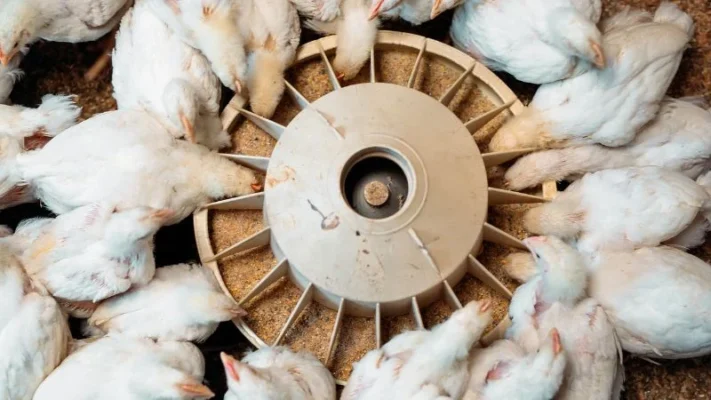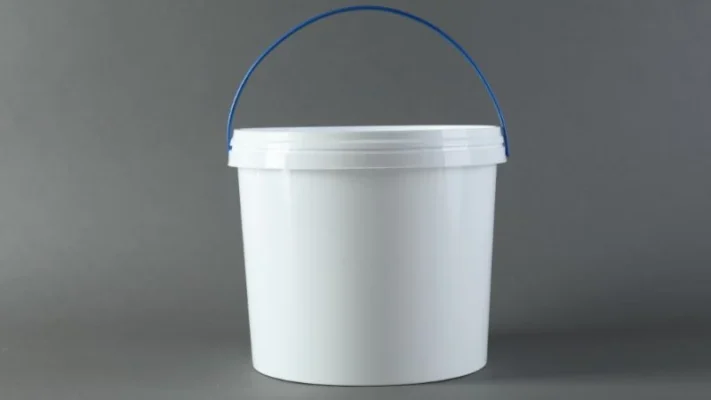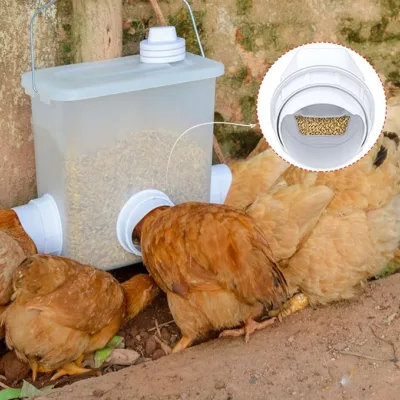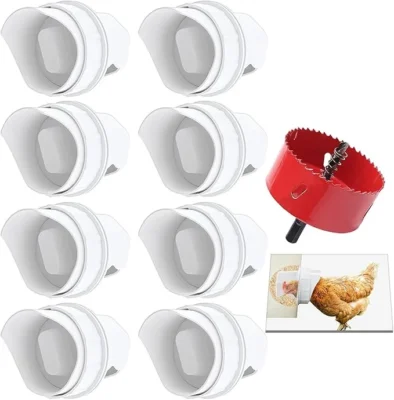I remember getting a call from my cousin about two years ago. He had just started raising chickens and was frustrated that he couldn’t find a proper 5 Gallon bucket chicken feeder. The larger feeders were too bulky and expensive for his small backyard flock of just a few hens. I totally got it—this is a common struggle for many first-time chicken keepers. They need something compact and budget-friendly, but after searching through Amazon and local stores, they still come up empty-handed.
I just laughed and told him, “Give me two weeks—I’ll get you not one, but two 5-pound feeders.”
So, where did I find them?

Part I: The Problem with Small Chicken Feeders – Especially the 5 lb Size
When my cousin asked me to help him find a 5 lb chicken feeder, I realized that the market basically had nothing that really fit the bill. Most of the feeders available were made for larger flocks—20 lb, 40 lb, or even more. They’re designed for small farms or people raising dozens of birds.

For someone with just 2–4 chickens, those large feeders just don’t make sense. They take up too much room in the coop—space that backyard chicken owners often don’t have. Plus, uneaten feed sits too long, gets clumpy from moisture, attracts bugs, and becomes a hassle to clean.
For beginners who just want to try raising a few hens for fresh eggs or to learn the ropes, buying a large, expensive feeder is a waste. It’s also not flexible if you want to scale up—or down—later.
So yes, the need is there. But for some reason, the market hasn’t kept up.
Part II: From Bucket to Feeder – A Simple, Flexible DIY Solution
Two weeks later, I showed up at my cousin’s place just like I promised. As I walked into the backyard, he looked around, puzzled:
“Wait, I thought you were bringing the feeders? Did you forget?”
I just laughed, patted him on the shoulder, and said,
“Relax—your chickens will be eating from new feeders in 10 minutes.”

Still confused, he watched as I popped open my car trunk and pulled out a few things: two old 5-gallon plastic buckets, a couple of small plastic feeder ports I had ordered online, and a handheld hole saw.
I found the right spot near the bottom of each bucket and started cutting holes to fit the ports—those little openings where the chickens stick their heads in to eat. Within about 5 minutes, the first 5 gallon bucket chicken feeder was ready to go.
My cousin’s face lit up with an “Ah-ha!” moment. He turned the bucket around in his hands and laughed:
“Seriously? This is so simple—I could make ten of these myself.”
Exactly. Not only is it cheap, but it’s also easy to make and super customizable. You can use 3-gallon buckets, 7-gallon buckets—whatever you’ve got lying around. And if you’re feeding different types of chickens, you can make separate feeders for each feed type without breaking the bank.
Part III: Outstanding Benefits of DIY Chicken Feeders Made from Buckets
From the very first time I built a 5 lb feeder for my cousin, I realized this wasn’t just a quick fix — it was a genuinely effective solution. In fact, it outperformed many of the ready-made feeders on the market, especially for small-scale backyard chicken keepers.

1. Easy to scale up as your flock grows
You can start with a small 3–5 gallon bucket and one or two feeder ports for a few hens. Later, if you expand your flock, just switch to a larger bucket, drill a few more holes, and add extra ports. No need to replace the entire feeder or reinvest in a new setup.
If you’re looking for larger feeders for bigger flocks, check out our post on the Best 40–50 lb Chicken Feeders.
2. Customizable for different types of chickens and feeds
Whether you’re raising bantams, heritage breeds, or hybrids, they often require different types of feed. With this DIY feeder setup, you can easily make separate buckets for different feed types. It’s a great way to manage portions and keep your coop more organized.
3. Budget-friendly
Feeder ports are widely available online — many come bundled with a hole saw. As for the buckets? Most folks already have some lying around — old paint buckets, compost bins, water containers — they all work. If you do need to buy one, it’ll cost no more than $5–7. Compare that to $50+ for commercial feeders, and the savings really add up.
4. Easy to clean, maintain, and replace
Cleaning is a breeze — just rinse the bucket with a hose and remove the ports if needed. If any part breaks, you only need to replace that one component — no need to toss out the whole feeder.
5. Perfectly aligns with the DIY spirit of backyard chicken keeping
Backyard chicken keeping isn’t just a hobby — it’s a lifestyle. It’s about self-sufficiency, sustainability, and being hands-on. Building your own feeder doesn’t just save money — it gives you that empowering “I built this” feeling that so many backyard farmers love.
Part IV: Where to Buy Feeder Parts – My Recommended Feeder Ports
The 5 lb feeder I “gifted” my cousin only took 5 minutes to make — but the key was having the right feeder ports ready to go.
I used high-quality plastic ports with built-in rain caps, rounded edges to protect your chickens, and a slanted design to prevent feed from spilling. The best part? You just drill a 3-inch hole and screw them in. No glue, no tools beyond a basic hole saw, and absolutely no special skills required.
I ordered mine on Amazon—it arrived in just two days, the price was great, and the package included 8 feeder ports and a hole saw with the correct diameter. It was super convenient and perfect for setting up multiple DIY feeders.

You can check it out here: DIY Chicken Feeder Ports (affiliate link – if you order through this link, I’ll earn a small commission to help keep this blog running — thank you!).
Part V: Tips for Building and Using a DIY Bucket Chicken Feeder
A bucket feeder is a flexible and budget-friendly solution, but to make the most of it, keep the following tips in mind:
• Choose the right type of bucket: Most repurposed plastic buckets—such as paint buckets, car wash buckets, or food-grade pails—can be used. However, make sure the bucket is clean, free of chemical residue, and made of durable plastic that won’t crack or break easily.
• Store it in the shade and protect from the elements: Plastic buckets don’t handle prolonged exposure to sun or rain very well. Place the feeder inside the coop or under a cover to extend its lifespan and prevent feed from overheating or growing moldy.
• Avoid leaving excess feed overnight: Even if your feeder is elevated, rodents can still climb up and chew through plastic to access the feed. (To learn more about rodent-proof options, check out our article on Best Rat-Proof Chicken Feeder for Backyard Coops.) It’s best to calculate a daily portion and remove any leftovers in the evening. Here’s a rough feeding guide based on the age and type of chickens to help you estimate:
| Chicken Age | Type | Feed per Chicken/Day | 3 Chickens/Day |
| 7–12 weeks | Growers | ~0.25 lb | 0.75 lb |
| 12–20 weeks | Pullets | ~0.3 lb | 0.9 lb |
| Adult | Layers / Broilers | ~0.4–0.5 lb | 1.2–1.5 lb |
For example, if you’re raising 3 pullets as shown in the table above, they consume about 0.9 lb of feed per day. To avoid having too much leftover feed overnight, you can start by filling the feeder with around 1 lb for one day or 2 lb for two days, then adjust based on what you observe. Keep in mind that their feed intake will gradually increase as they grow.
• Chickens might need time to adjust: With feeder ports, chickens will need to explore and learn where the food is. You can sprinkle some feed near or just outside the port to “invite” them over—once they investigate, they’ll figure it out quickly.
• You don’t have to buy pre-made feeder ports: If you enjoy DIY projects and have some basic tools, you can replace the ports with PVC elbow fittings. This option requires more precise drilling and angling to prevent spillage, but it can save money and offer a more hands-on, satisfying build.

Conclusion: A Simple Feeder, a Flexible Solution for Small-Scale Chicken Keepers
What started as a small need—a 5 lb feeder for just a few chickens—led my cousin and me to discover an effective and surprisingly versatile solution: a homemade chicken feeder using a plastic bucket and screw-in feeder ports.
It’s easy to source materials, simple to assemble, and easy to scale as your flock grows. That’s exactly what backyard chicken keepers need.
Compared to commercial feeders that often cost $50 or more, this DIY option is far more affordable, fully customizable, and a great creative project for beginners. If you’re just starting with a few chickens or considering backyard poultry, I truly recommend giving this type of feeder a try—you’ll find chicken keeping is not only manageable but can also be a lot of fun.
👉 Want to explore more feeder options tailored to your flock’s needs?
Check out our comprehensive guide on selecting the right chicken feeder based on flock size, coop conditions, and feeding habits: How to Choose the Right Feeder for Your Backyard Flock.

